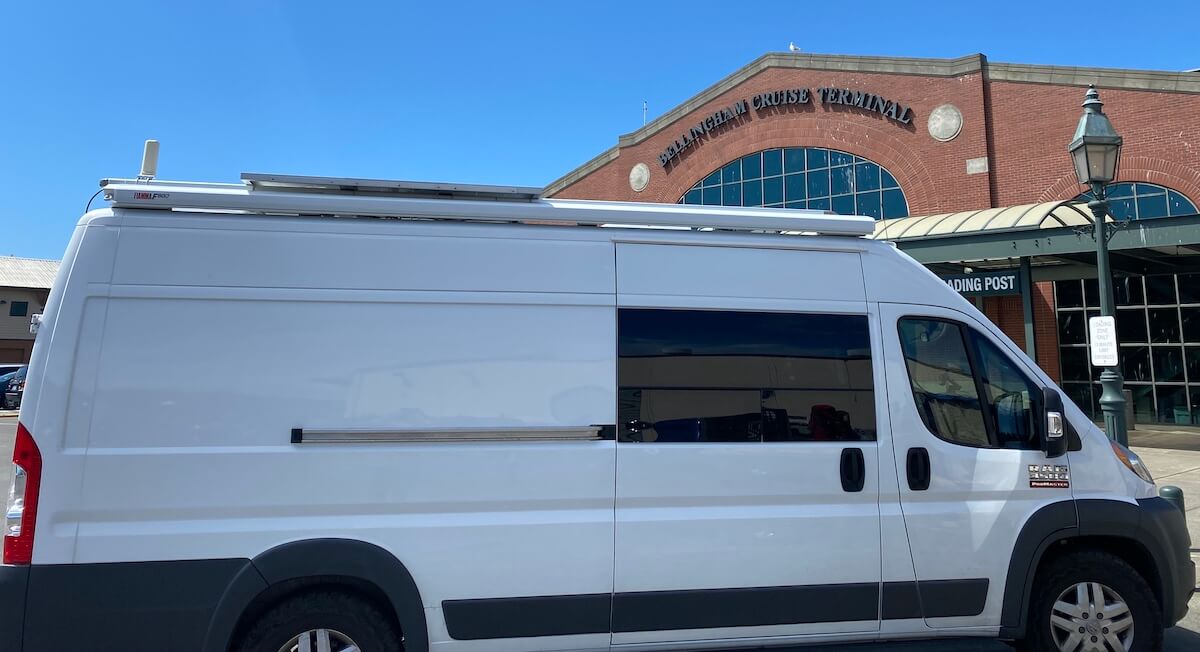The goal for our first summer in the van was always Alaska, however when the pandemic caused the border between Canada and the United States to close for all non-essential travel, we assumed our plan was dead in the water. The thought of taking a ferry never crossed our minds until we visited Bellingham, WA in early spring and saw all of the Alaska ferry traffic signs and we decided to look into it. Even though it would cost a pretty penny, we knew taking the ferry would allow us to see more of the state than we would have gotten to otherwise and having less tourists around definitely excited us. We discovered that information on what to expect with the ferry was difficult to come by, and in sharing our journey, we hope to help others that are looking into this option of travel.
Booking tickets
The hardest part of the booking process was deciding which route to take. Our original plan was to take the ferry directly from Bellingham to Whittier. After looking at the route map and deciding what our priorities and top “must sees” were, we decided to take the ferry from Bellingham to Ketchikan, Ketchikan to Sitka, Sitka to Juneau, and Juneau to Whittier, spending a week or two at each port depending on the next ferry’s availability. We learned that being flexible on port “layovers” and departure dates allowed us to leave much earlier than taking a ferry directly to Whittier.
To book boarding passes for both of us and the van, they needed to know how many people were coming, the length of our vehicle, and if we would be traveling with any pets. And just like that, our trip to the 49th state was booked.
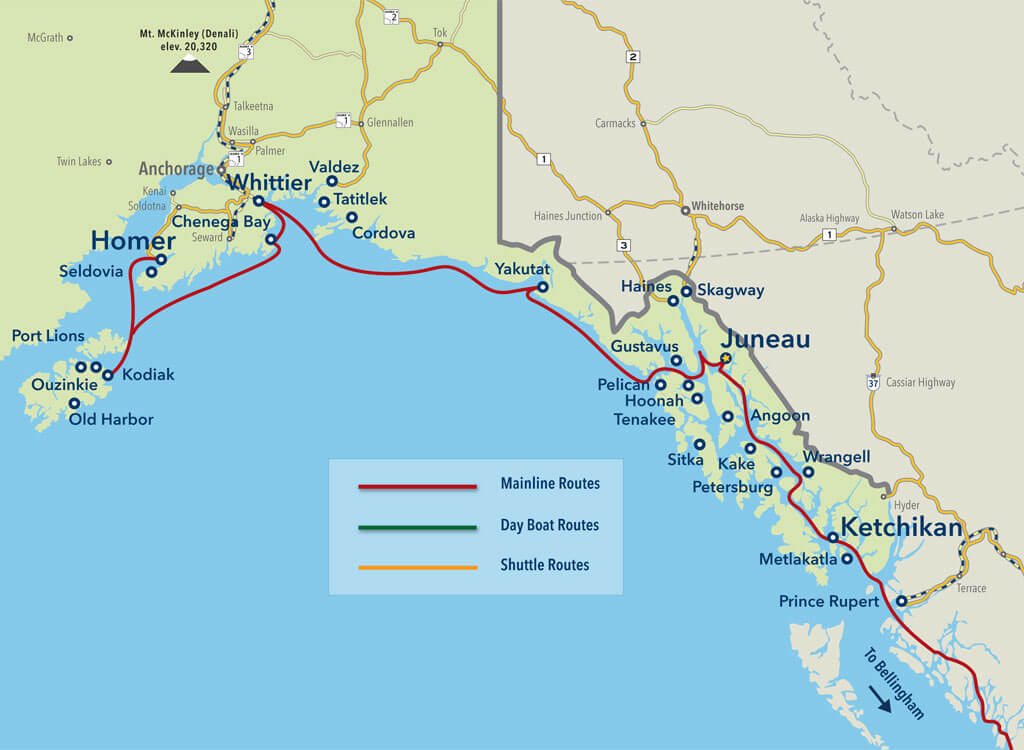
Photo Credit Alaska Marine Highway System
Check in
Check in was a bit scary because Alaska Marine Highway does not provide any information on what to expect other than a time that you need to arrive at the terminal. We arrived at the Bellingham ferry terminal at 3:00 pm for our 6:00 pm departure. At the check in counter, they asked for our government-issued IDs, clarified our vehicle and state room requirements, and printed off our boarding passes. There were boarding passes for the 2 of us and 1 for the van that needed to be put on the inside of our windshield. The entire process took a total of 3 minutes. We were then instructed where we needed to drive to get in line to board.
At the vehicle staging entrance booth, they asked if we had propane or firearms with us and put a piece of tape on the windshield based on our answers, and then told us which lane to wait in.

Boarding
They board the ferry based on port and vehicle size. The entire process took about an hour and a half and we were one of the last few cars to board. When it is your turn, they check your boarding pass and ID at the loading ramp and then direct you where to park. You have a few minutes to gather your belongings and then head up the stairs.
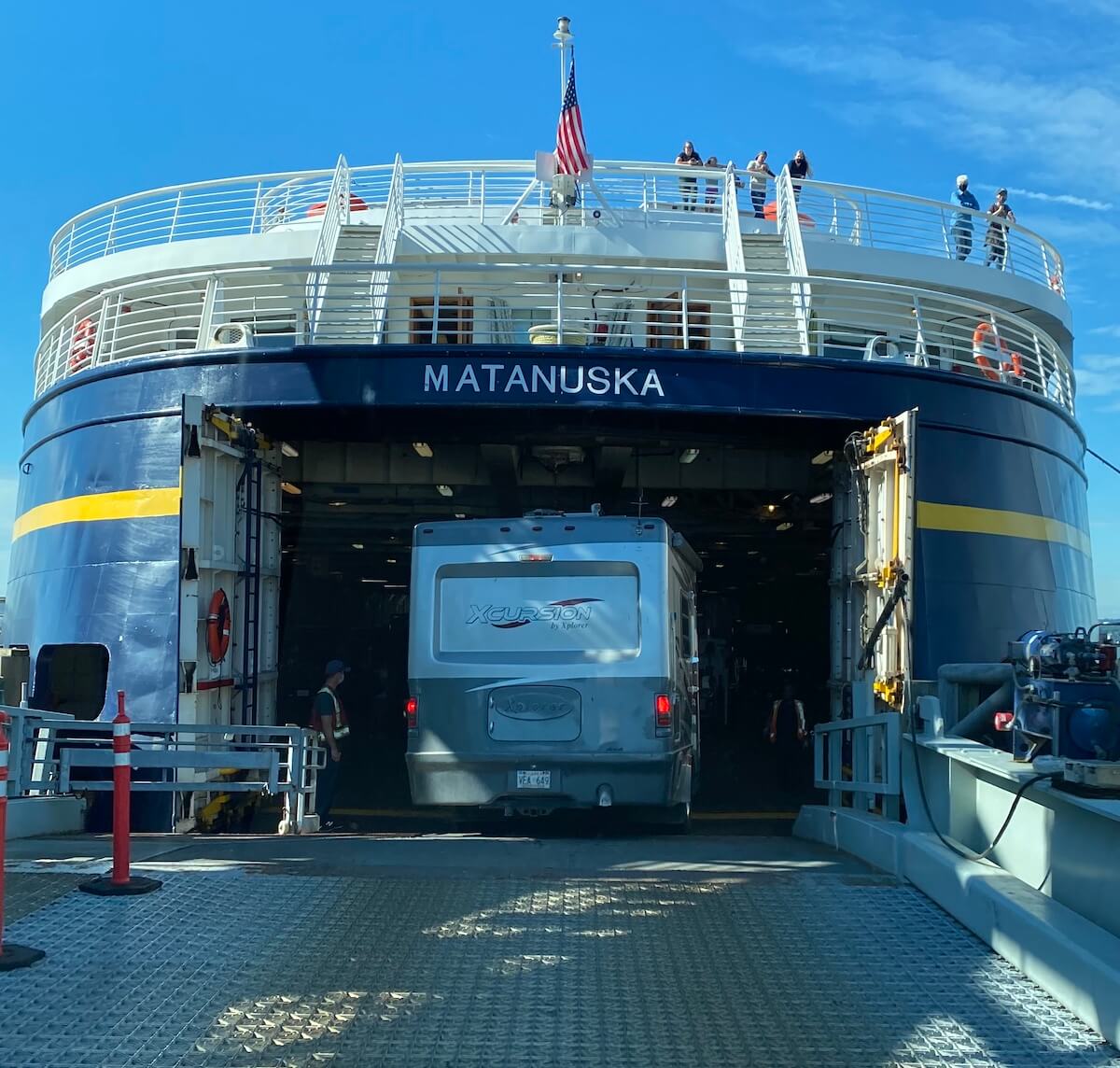
We were a bit concerned that we didn’t have any information about our stateroom at this point, but when you board the ship, there is an office on the cabin deck where you get your room assignment and keys.
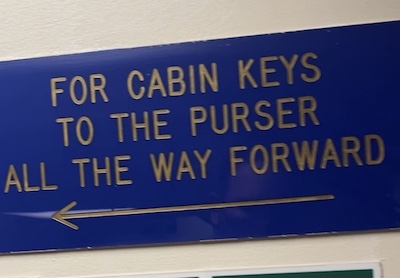
Sleeping options
Unfortunately, you cannot sleep in your vehicle on the ferry. If you do not want to spend money on a stateroom, you can either pitch a small tent and camp on the back deck (space is first come, first serve), or you can sleep in any of the lounge areas around the ship. Lockers are available to store your luggage.
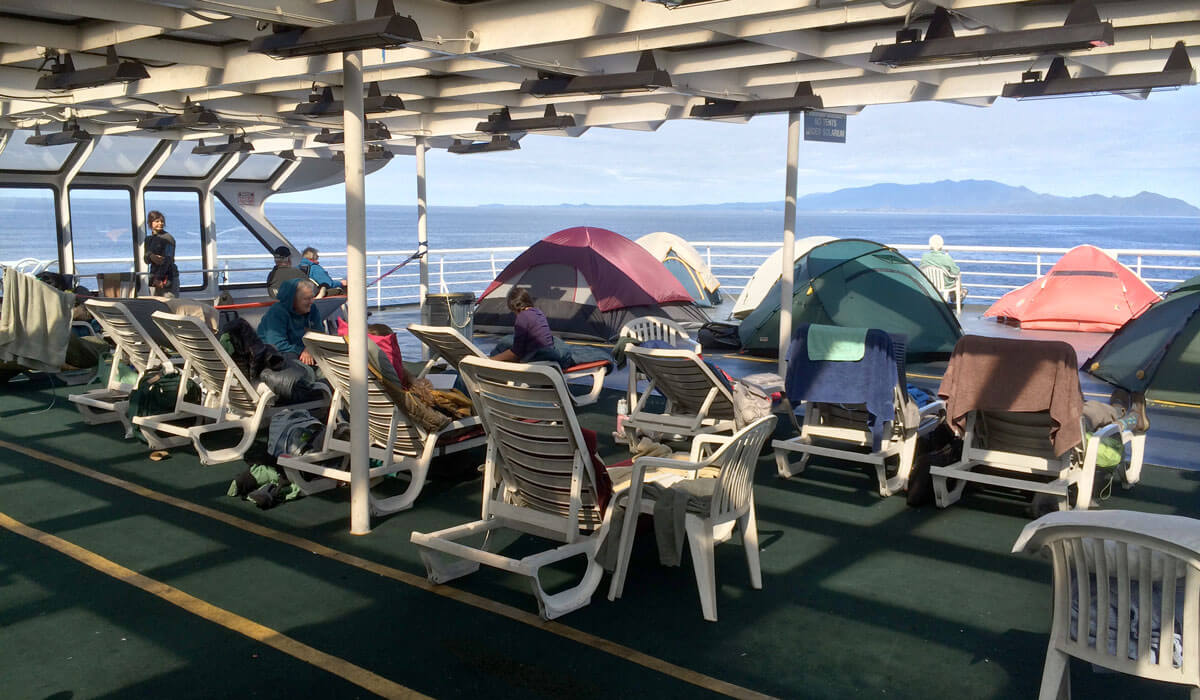
Photo Credit Alaska Ferry Camping
If you’ve never been on a ship before, know that the rooms are small. As far as staterooms go, there are 4-berth rooms (4 beds) or 2-berth rooms (2 beds) that come with private bathroom facilities, or 2-berth roomettes that do not offer any private bathroom amenities. You can also choose between an inside room (no window) or an outside room (window). The 4-berth and 2-berth rooms come with linens (towels, sheets, pillows, etc.), but the roomettes do not. Linens are available for an extra fee, or you can bring your own.
A word of warning
It is pretty loud in the staterooms. There are lots of creaks and rattles, and you can hear everything that happens in the hallways, so don’t expect a great night of sleep.
Food options
On our ferry, the Matanuska, there are vending machines available with snacks and soda, as well as a cafeteria. The cafeteria provides both hot and cold options that change throughout the day. In non-COVID times, we are sure this functions more like a buffet, but for the time being, they have pre-portioned servings available for you to take as you move down the line, and a grill for made-to-order hot food items. Plan to be in line for a significant amount of time. We tried to arrive to meals early, and still usually ended up waiting 30-45 minutes.
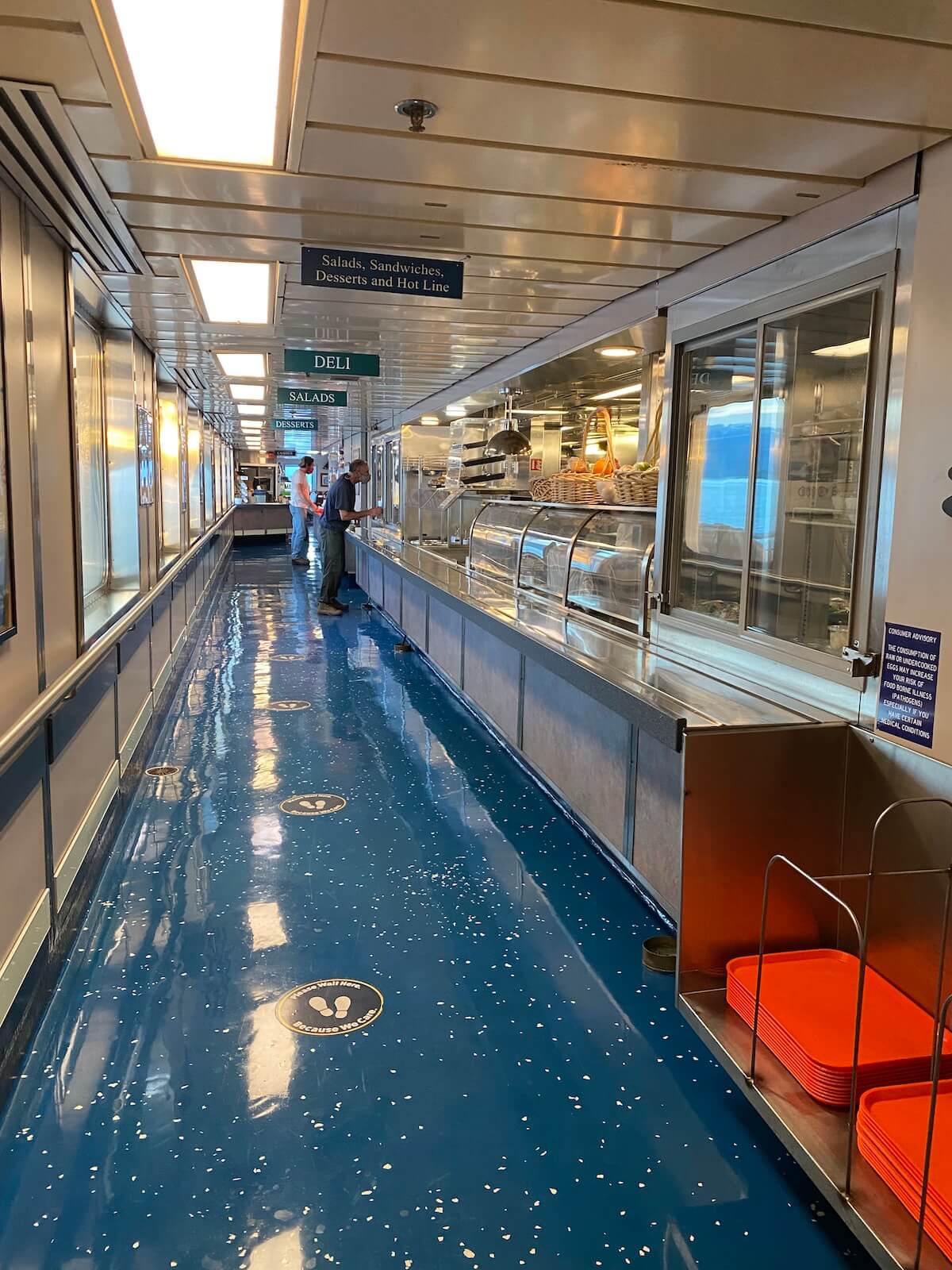
Food prices were surprisingly reasonable and we found ourselves spending $15-30 per meal for the both of us. They sell soda, coffee, tea, juice, and milk, and water fountains were available in different parts of the ship. We did not see any alcohol on our ship. While refrigerators are not available, you can buy ice for $0.25 from a vending machine. Consider bringing a cheap cooler and picking up a 6-pack or two of your beverage(s) of choice to keep with you in the room to save some money.
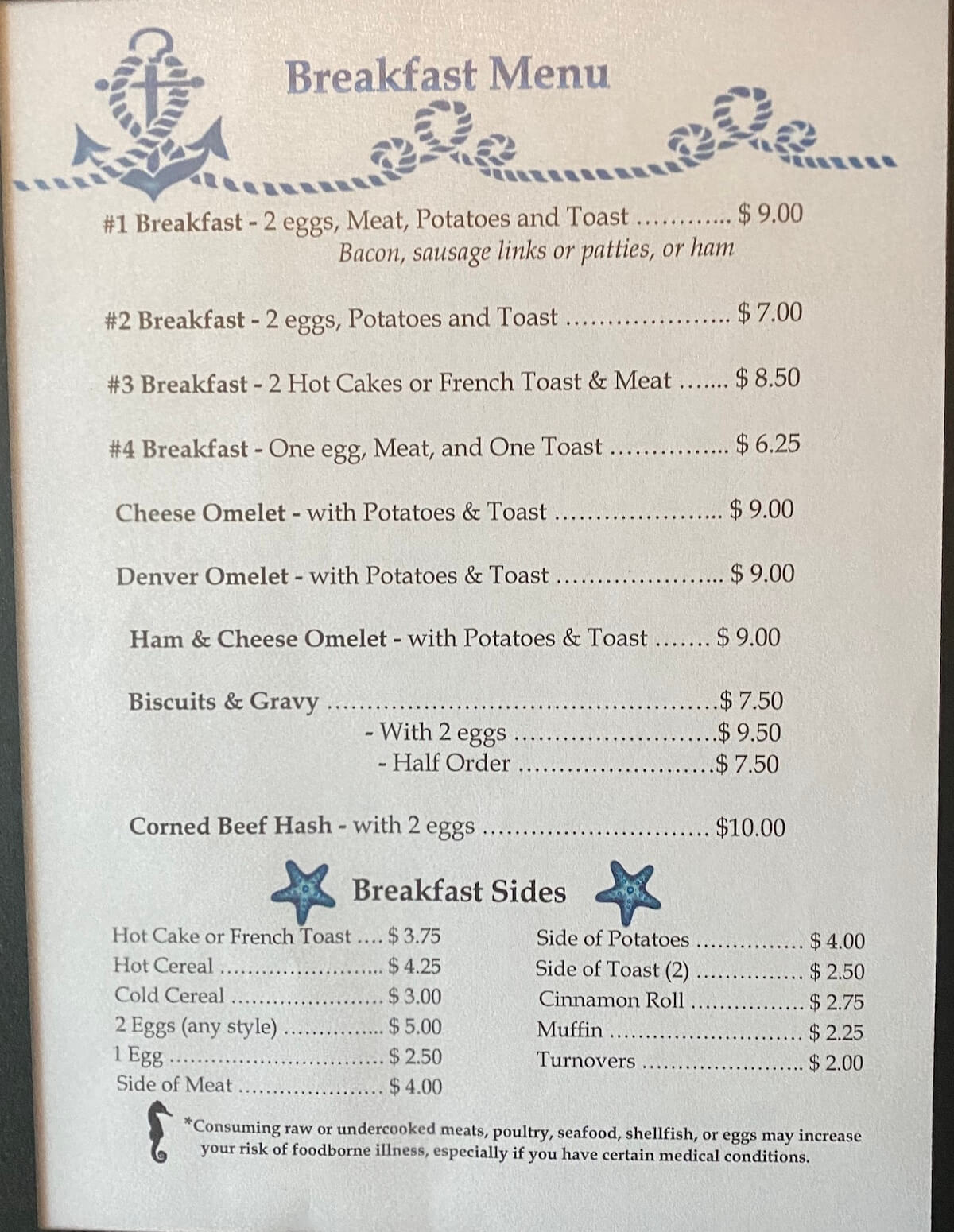
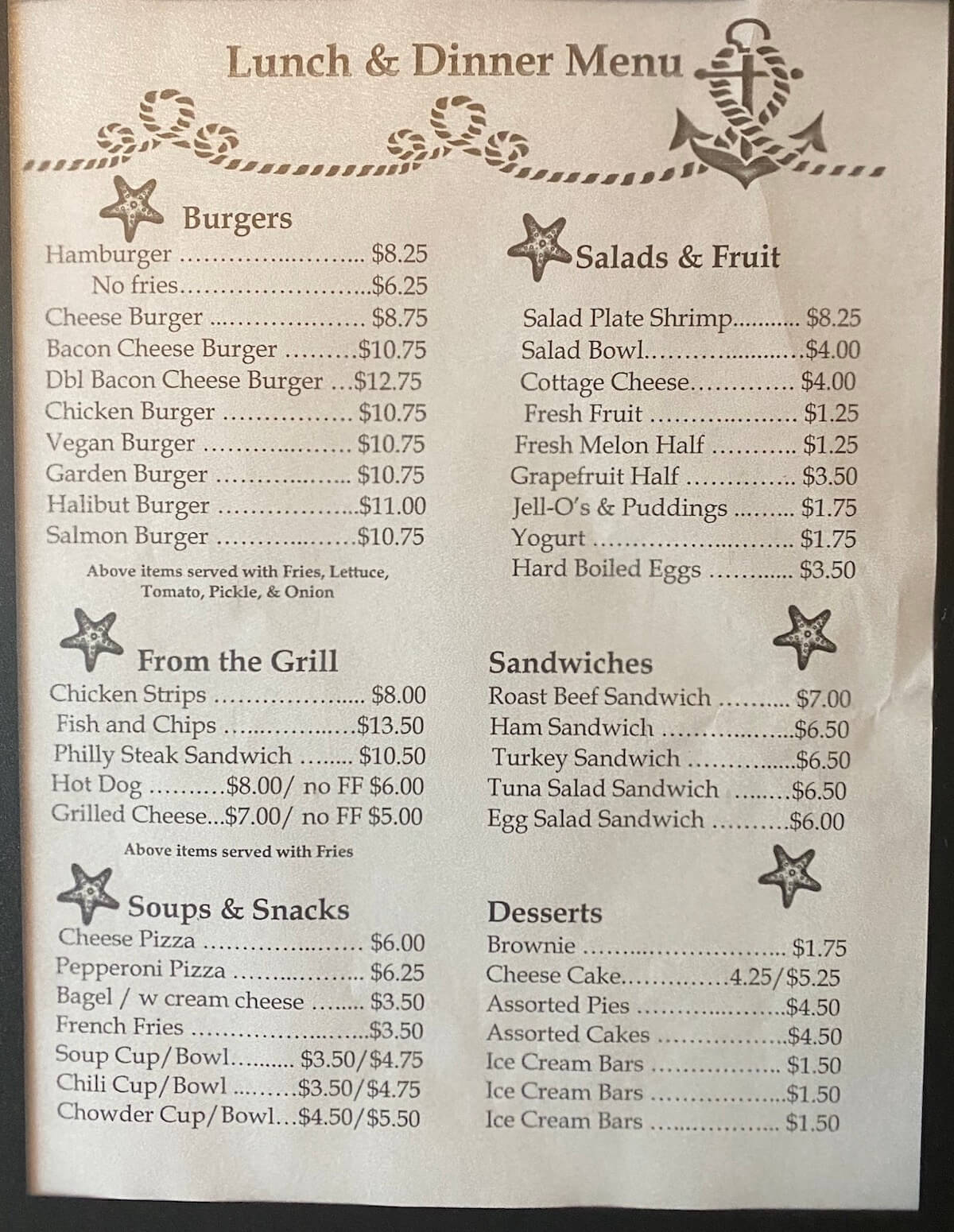
If you are looking to go as cheaply as possible, there are microwaves available. Lots of people brought ramen, backpacking meals, and other shelf-stable foods to heat up. Condiments are also free of charge, things like saltine crackers, peanut butter, jelly, hot sauce, ketchup, mayo, creamer, sugar, etc.
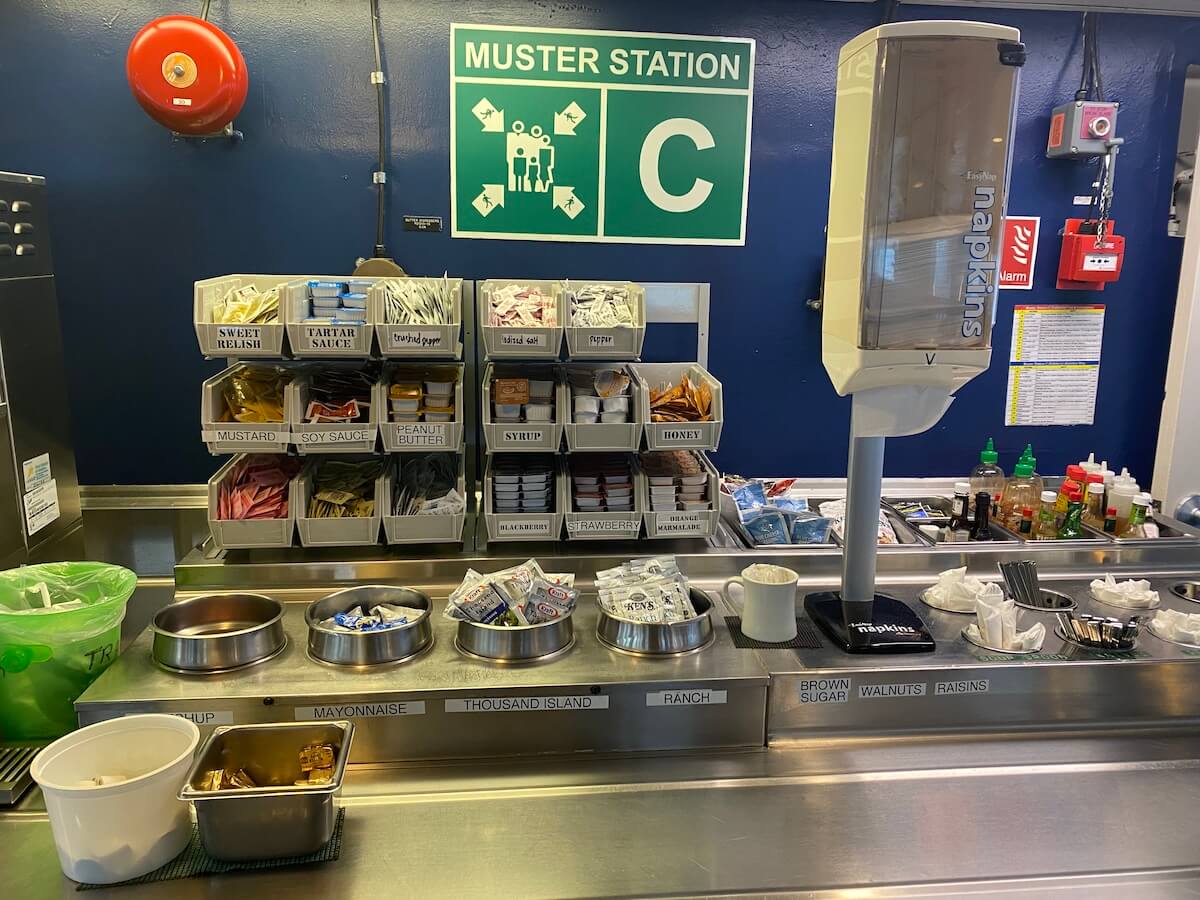
Bathrooms/showers
Staterooms with full facilities come with their own shower, sink, and toilet. If you book a roomette or choose to tent camp/sleep in the lounges, there are plenty of public restrooms around the ship and shower stalls for all passengers to use that look similar to what you’d find in a gym.
Car deck openings/pets
You only have access to your vehicle while the ship is in port or during the limited car deck calls. If you are traveling with a pet (pets are required to stay on the car deck at all times) or need to retrieve something from your vehicle, there are four 15-minute car deck calls per day. On our ship, the car deck calls were at 8:30 am, 2:30 pm, 8:30 pm, and 12:30 am. During this time, you can walk/feed/potty your pet and grab anything you need from your vehicle. They will make an announcement over the speaker to let you know when the car deck is open and when it is closed.
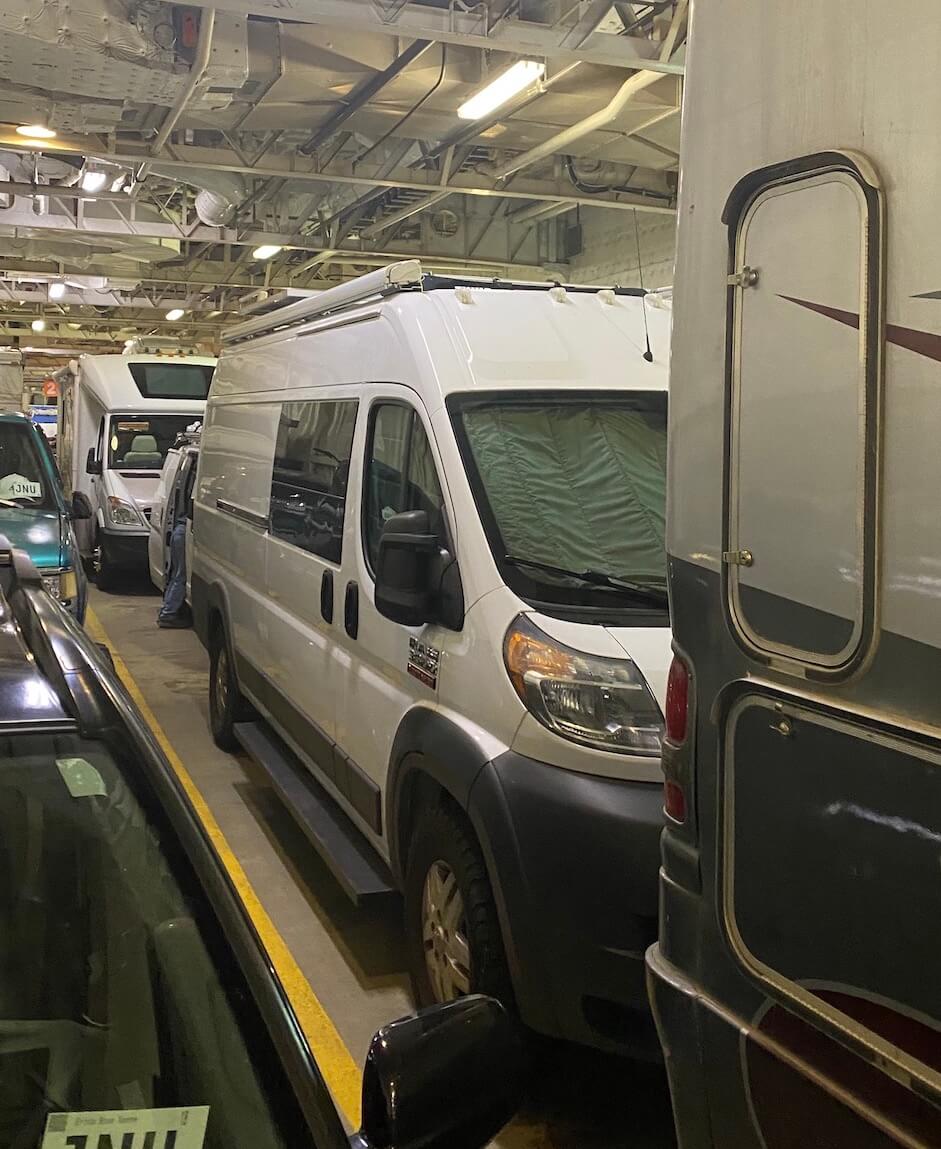
For the sailing and car deck schedule for your particular trip, be sure to check out the posted times located behind the purser counter on the cabin deck. They will be able to answer any questions you may have.
Entertainment
They call this a “poor man’s cruise” for a reason, there is not much to do. There is no cell service and no WiFi, so make sure to download any books, podcasts, or movies beforehand. There are a few games, puzzles, and decks of cards provided for passengers to help pass the time, and even a small play place for kids, however the majority of entertainment will be found outside looking at the views.
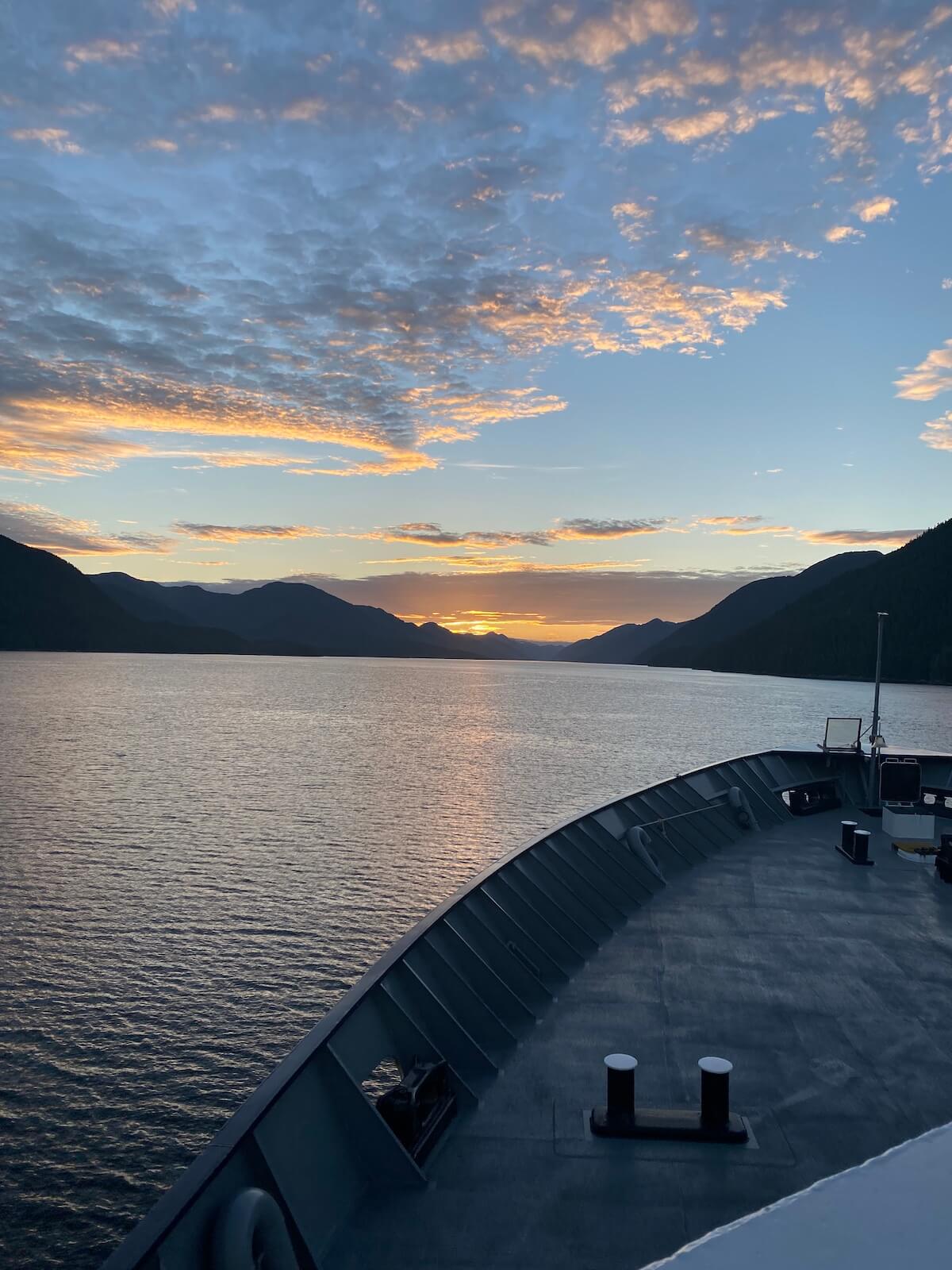
We recommend bringing some binoculars because we saw lots of whales and other sea life along the way.
Check out/Debarkation
On Alaskan Marine Highway ferries, they will announce your arrival to each port 30 minutes before the ship arrives. If you are in a stateroom and getting off the ferry at that port, they will knock on your door 30 minutes prior as well. All you have to do to check out is drop your room keys off in the key box at the purser counter and wait for the announcement that it is okay to go down to the car deck.
Overall experience
Our overall experience was positive. This is a once-in-a-lifetime trip, but we don’t intend to do it again. The views are indescribably beautiful, and we got to see so much wildlife (is there such a thing as too many whales?). The ferry also allows you to visit places you can’t necessarily drive to and saves your vehicle from the wear and tear of those long miles through Canada.
The downsides would be overall price and the toll the journey took on our bodies. Neither of us slept well, if at all, and while the ship does travel through relatively well-protected water, it was very clear when we were in the open ocean and we both had a hard time with sea sickness. Definitely bring Dramamine with you if you struggle with motion sickness.
Price
Now, the part you have all been waiting for: how much did this all cost? We are going to be honest with you, this trip was expensive. There are ways to save money by doing things like booking further in advance or traveling in the off season. You can also save by not reserving a stateroom. But here is the price breakdown for each leg of our trip:
Bellingham to Ketchikan (36 hours)
Boarding passes for 2 adults: $718
Short RV (<=25 feet): $1,326
2-berth inside stateroom: $380
Total: $2,424
Ketchikan to Sitka (48 hours)
Boarding passes for 2 adults: $270
Short RV (<=25 feet): $369
2-berth outside stateroom: $240
Total: $879
Sitka to Juneau (10 hours)
Boarding passes for 2 adults: $178
Short RV (<=25 feet): $212
Total: $390
Juneau to Whittier (36 hours)
Boarding passes for 2 adults: $532
Short RV (<=25 feet): $1,108
4-berth outside stateroom: $633
Total: $2,273
Grand total
$5,966
Hours sailing: 130 (5 days 10 hours)
If you have any other questions about our experience on the Alaska ferry, reach out to us on Instagram @travelswithkevan. We would love to chat with you.

